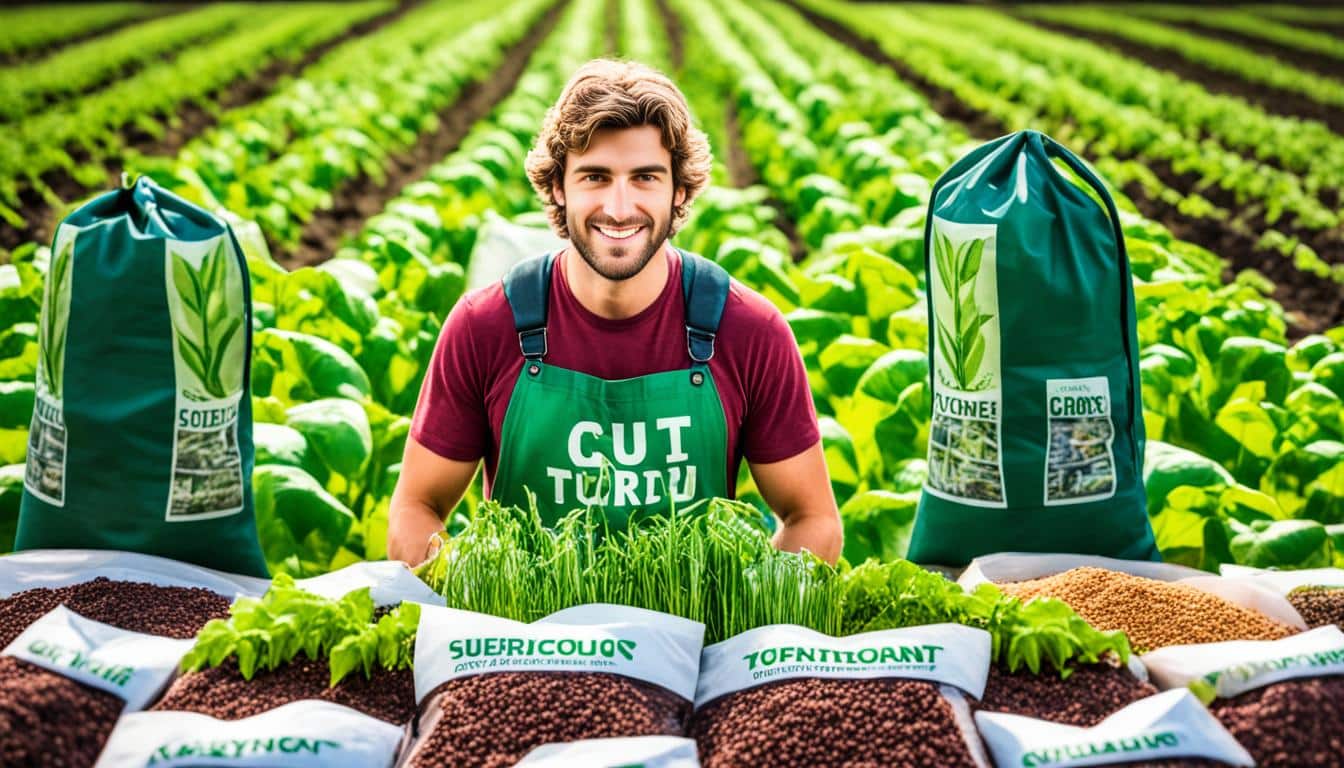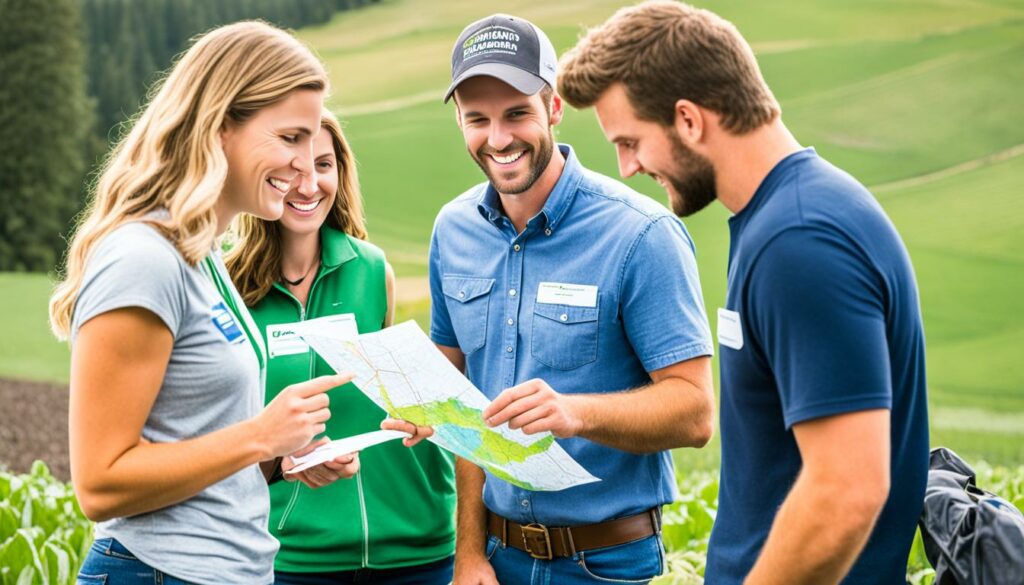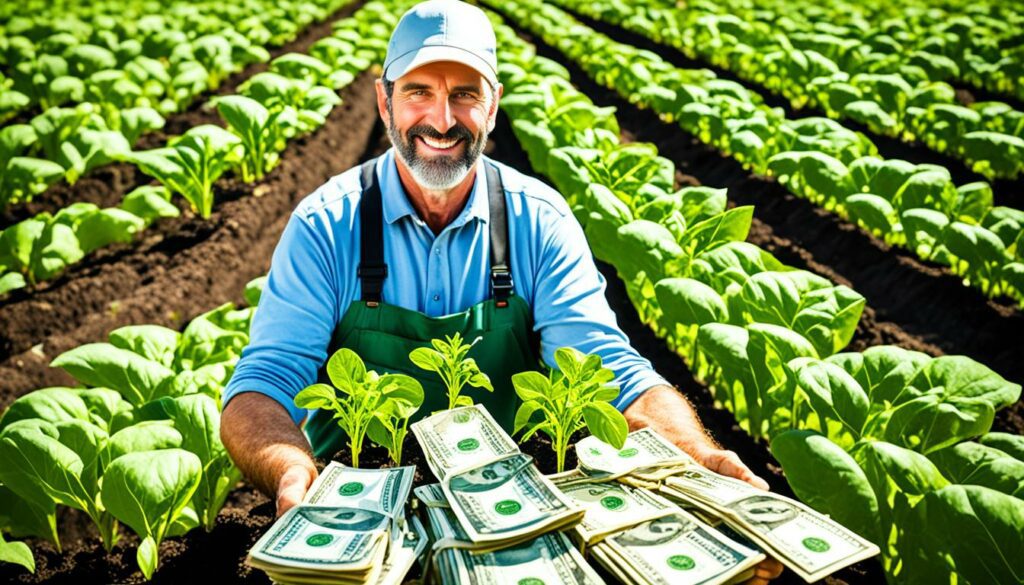Menu

In the United States, many federal government grants are for farmers with one year or more experience only. This hurdle makes it hard for new farmers to get funding. To get young farmer grants, you need to know the rules and manage your money well.
Beginner farmers, per the U.S. Department of Agriculture, are those who’ve farmed for less than ten years. If you’re new to farming or don’t have much experience, you can still apply for certain grants. But, you must show your farm business is likely to succeed. You’ll also need to meet credit standards like the ‘5 C’s of Credit.’
It’s very important to get funding for new farmers to bridge the financing gap. Grants can go up to $5,000, with 50 winners picked all over the U.S. These programmes look for projects that can solve real farming issues and last a long time. Getting help from local Beginning Farmer and Rancher Coordinators is also key to your application’s success.
Young people starting farm work need to know about the money side, especially how they can get support through farming grants. This support is vital for new farms to grow. While many grants seem to help bigger farms more, there are also help like tax breaks for those just starting.
To get this financial aid, they need to show they can manage money well and plan to be in it for the long haul. Making smart financial moves is key to using this help for lasting growth. New farmers should look into these options to get the most out of them.
| SNAP Statistics | Details |
|---|---|
| SNAP Participants | 40 million low-income Americans |
| Annual Cost | $80 billion per year |
| 2018 Deficit | Almost $800 billion |
| Health Comparisons | Increased diet-related disease risk for SNAP participants |
| 2017 Research Findings | Increased risk of death due to poor diets among SNAP recipients |
| SNAP Meal Allocation | Just above $2 per meal per person |
Smaller farming operations can benefit a lot from certain schemes. These programs aim to make new farms more financially secure and stronger in the face of tough times. Also, efforts like the Food is Medicine Working Group are showing how farming funds can also promote better health.
Working together, groups like the Kansas Rural Center are bringing more resources to support local food networks. For example, the USDA gave nearly $300,000 to Common Ground in 2020 to help train new business owners. They followed this with a $500,000 boost in 2022. It proves that well-thought-out money support really helps new farmers.
To get young farmer grants, it’s key to know the rules. Various agencies, like the USDA, have strict rules. These make sure the money goes to the right people. It’s important to understand the different kinds of farmers out there.

A beginning farmer is one who’s been farming for 10 years or less. This term also covers young people starting their farm careers. The 2018 Agriculture Improvement Act brought back the Beginning Farmer and Rancher Development Program. It helps by funding education and mentoring for new farmers. This support is crucial for those early in their farming journey.
| Grant Program | Funding (Per Year) | Duration |
|---|---|---|
| Food, Conservation, and Energy Act 2008 | $75 million | FY 2009 – FY 2012 |
| Agriculture Act 2014 | $20 million | 2014 – 2018 |
| Agriculture Improvement Act 2018 | Reauthorized funds | Ongoing |
It can be tough for new farmers to get funding. The Young Farmer Grants need certain things from applicants. You must be between 18 and 40 years old by May 1, 2021. They look at your need for money, if you’re sustainable, and if you help reach farming goals.
These grants give extra help to groups who don’t usually get it. Half of the winners should be Black, Indigenous, or other farmers of colour. Half should be women, nonbinary, or trans farmers.
Each grant is $5,000, and 50 people win across different places. They check how well you meet the farming goals, handle challenges, and if you’re sustainable. With just 25% success rate, it’s vital to align your application with their criteria.
Getting agricultural funding can be hard but essential for farm growth. Farmers can get help from government grants, private funds, and microloans. Let’s look at these different financial supports for farmers.
Government grants are a key support for farmers. The USDA has many programmes, from helping rural Americans buy homes to loans for new farmers. Programmes like the Specialty Crop Block Grant help make crops more competitive. The Farmers Market Promotion Program supports local markets. But, these grants mainly help big, well-established farms.
Private funds offer another way to get financial help. For example, private insurance companies work with the USDA. They provide insurance to farmers to lower their risks. Private loans and investments support different farm projects. These options can provide more help than just relying on the government.
Microloans are a crucial help for small or new farms. They are easier to get than regular loans, meant for those with fewer assets or less experience. The USDA makes sure these loans are there to help small farms grow. Microloans give farmers the money they need to start and keep their farms going.
Getting rural development grants needs a smart plan. Keep an eye out for news from Agri groups like the USDA. Use platforms that share funding info for young farmers. It’s also smart to network and stay in touch with Agri newsletters. This helps you stay updated on new funding out there.

Rural development grants are a big deal for young farmers just starting. The USDA has many programs to help out. They offer loans through the Farm Service Agency to help you start. The USDA also supports building affordable rental housing for farm workers.
Have a look at the Specialty Crop Block Grant Program (SCBGP) for help with fruits and veggies. Also, if you sell directly to consumers, check out the FMPP grants. These help make farmers markets and roadside stands better.
The USDA supports organic farming too. They help with the costs of getting certified. Plus, they have funds for teaching new farmers and helping out with tech stuff, like $24,000,000 from 2018’s Ag Improvement Act.
In short, dig deep and connect to find funding if you’re a new farmer. Using state resources and keeping up with news can really help. They can lead you to good agricultural grants for your farming plans.
| Grant Opportunities | Target Beneficiaries | Funding Scope |
|---|---|---|
| USDA Direct and Guaranteed Loans | Beginning Farmers and Ranchers | Direct and guaranteed loan funds |
| USDA Multi-Family Housing Programs | Low-Income Families, Elderly, Disabled | Rental Housing Loans |
| SCBGP Funds | Specialty Crop Growers | Competitiveness Enhancement |
| FMPP Grants | Producers and Direct Market Sellers | Market and Stand Expansion |
| Organic Certification Cost-Share | Organic Producers and Handlers | Certification Cost Assistance |
Getting ready for the grant application process means you have to be fully prepared and pay close attention to detail. Young farmers who know how to smoothly go through this process can get a lot of money. For example, the PA Farm Bill Agriculture & Youth Grants have given more than $150 million to different agricultural projects.
Putting together the required documentation is very important for your grant application. You will usually need to show your experience, your financial situation, and references. To get grants that go up to $7,500 or matching ones that go up to $25,000, it’s crucial you have strong financial records. You should also have a lot of evidence showing you are eligible.
Since 2019, the PA Ag & Youth Grants have put $1.5 million into 157 projects across the state. This shows how important it is to have clear, accurate documentation to get these funds.
Writing a compelling proposal is key for your grant application’s success. Your proposal should tell a story about your farming, explain your future plans, and show how funding will solve your problems. For grants aimed at new farmers, focus on how sustainable your farm is, why you need the money, and how it will help your business grow. It’s interesting that the PA agriculture industry is worth $132.5 billion and needs farmers to stay dynamic.
It’s also really important that your writing is clear and makes sense. All grant applications must be submitted before 5:00 PM on September 29, 2023. You still have time to fine-tune your documents and proposal to fit the guidelines in the August 12 PA Bulletin. By being very thorough in your preparation and showing your vision clearly, you can make the most of these grants for new farmers.
Writing a winning grant proposal involves several key steps. You need to match your goals with the funder’s, show how your project plans to last long, and be clear about your financial needs.

It’s vital your project matches the goals of the funding group. They often define what they want to achieve. For example, after the 2008 Farm Bill, support increased for small scale farmers. Showing how you fit these aims can help your application stand out.
Using sustainable methods is key in today’s grant selections. Show you care about the planet, from how you manage resources to farming ethically. Talk about how you save the environment, work more efficiently, and ensure your project’s long-term success. Sharing detailed plans and showing your commitment to being green can make a big difference.
Making your financial case solid is crucial. Explain in detail how the grant will meet crucial needs not covered by other funds. Remember, many grants have specific rules and might not help buy major things like land or machines. Showing how the grant fills essential gaps can make your proposal stronger.
“Presenting an organized proposal with a logical train of thought and a concise explanation increases the chances of success.”
For a successful grant proposal, focus on planning, clear writing, and how well your project fits the funder’s goals. Stick to these tips to boost your chances of getting the funding you need for your farming projects.
Being good with money is key in the fight for farm funding. Keeping clear financial records makes you look reliable to grant givers. This shows your farm is strong and trustworthy.
Accurate financial records are vital. They tell the story of your farm’s financial health. This helps you plan for the future and prove to banks that you’re reliable, according to Texas A&M’s AgriLIFE Extension System. Plus, they make your grant application stand out.
FarmRaise Tracks is a game-changer. It makes managing finances easier by helping with budgets and expenses. This tool makes your financial data clear and organized, improving your chances of getting a grant.
Good financial management and tools like FarmRaise Tracks are a powerful team when applying for grants. They show you’re prepared and trustworthy.
Using state resources and connecting with *Beginning Farmer and Rancher Coordinators* is key for new agricultural businesses. These coordinators offer specific help to make the application process clearer. They link applicants with the right organisations. Local agriculture departments are also crucial in opening doors to support programs. These programs help ease the start-up costs for new farms.
State resources are essential for providing grants and support to new farmers. Working with coordinators from each state helps applicants navigate the complexity of grant applications. This guidance increases the chance of getting the needed funding.

In 2023, the impact of state-funded programs was quite significant. *Farm Aid* gave out $1,346,015 in grant funding. The End of Year Grants programme supported 97 organisations with $955,500. These numbers underscore the vital role of strong state and local support.
Emergency and strategic grants are important for both immediate help and long-term stability. For example, $35,500 in emergency grants went to individual farmers. Strategic grants of $194,500 supported causes such as helping Native American farmers and rural communities.
Besides direct aid, state resources also focus on the development of leadership skills in farming. In 2023, $23,015 was provided to enhance the leadership of farmers. This helps them have a stronger voice in the agricultural sector. It shows the diverse support from state programs for new and current farmers.
| Type of Grant | Amount Distributed | Beneficiaries |
|---|---|---|
| Farm Aid | $1,346,015 | Various organisations and individuals |
| End of Year Grants | $955,500 | 97 organisations |
| Emergency Grants | $35,500 | Individual farmers |
| Leadership Grants | $23,015 | Agricultural leaders |
| Disaster Support Grants | $120,000 | Flood and hurricane-affected regions |
| Strategic Grants | $194,500 | Various causes, including Native American producers |
Taking advantage of state resources and working with *Beginning Farmer and Rancher Coordinators* helps new farmers. This support lets them concentrate on making their farms sustainable and successful. It lowers the financial risks of starting new agricultural businesses.
Young farmers often face many hurdles when they try to get obtaining agricultural grants. These include strict rules they must meet. There are also big issues in the agricultural sector challenges, like how the markets work and looking after the environment.
Grabbing agricultural grants is tough, especially for those new to farming. Starting out, they might find it hard to get land or money. Also, they need to learn a lot about farming. In Northern Illinois, a lot of young farmers want to sell locally. But, they find it hard to keep their farms going. This is because they often have to work elsewhere to make ends meet.
Extension professionals help a lot in overcoming barriers. They work with farmers to figure things out. Projects like these in Illinois get support from the College of Agricultural, Consumer and Environmental Sciences. They also get help from the University of Illinois’ Office of the Provost Investment for Growth Program.
The main farmers getting older is a growing issue, as young people have a harder time joining. Since 1978, the average farmer’s main age went from 50.3 to 58.3 years in 2012. This means efforts are needed to help young people get into farming.
A lot of young farmers have big student debts. This makes it tough for them to get some USDA loans. The National Young Farmer Coalition is fighting for a solution. They want young farmers to be able to get help from the Public Service Loan Forgiveness Program if they farm full time.
Here’s a quick look at the challenges and potential solutions:
| Challenge | Impact | Proposed Solutions |
|---|---|---|
| Access to Land | Limits farm establishment | Use of state resources, land link programs |
| Financial Capital | Hampers operational scale | Exploring USDA’s favourable loan terms |
| Student Loan Debt | Restricts loan eligibility | Advocacy for loan forgiveness policies |
| Lack of Local Markets | Reduced sales channels | Partnering with Extension programs |
To overcome agricultural sector challenges, farmers need to be smart and strong. Showing they can beat these obstacles is key to winning grants.
Learning from others’ experiences in getting grants is key. Success stories show how funding can change lives. They also reveal the power of thinking differently when applying for grants. Let’s look at Leo Morrissey, a young farmer in Ireland. He showed how the Rural Development Programme (RDP) 2014-2020 helped him.
Leo Morrissey found success through unique grant applications. He used the TAMS II scheme to improve his farm with better sheep fencing. Instead of the Collaborative Farming Grant Scheme, Leo and his brother chose a different approach. They did this because of their parents’ age and the good state of the farm’s finances. This move proves that customising grant applications to fit your needs is crucial.

Funding has significantly improved Leo Morrissey’s farm. Through TAMS II, he enhanced his farm’s structure and supported eco-friendly farming. Partnerships allowed him to merge with the older generation’s farm wisdom. This led to both the conservation of tradition and the drive for modern farming.
Leo’s story, picked up by top Irish newspapers, inspires other young farmers. It shows how clever grant applications can lead to success. The National Rural Network’s case studies back this up, demonstrating the big change proper funding can bring.
Case studies worldwide, from improving dairy farms in the US to better soil care through grants, paint a clear picture. Smart grant applications can revolutionize farming. They are not only lucrative but also better for the earth.
For first-time applicants, getting grants might seem tough. But, taking advice from experienced people can really help. It can make your chances of success much higher.
First-timers should consider getting help from experts. These advisers know the grant process well. They understand the specifics of grants like those for renewable energy or farm sustainability.
Such consultants can prevent you from making common mistakes. They also help you clearly state your farm’s goals and financial needs. This is very important for your application.
Talking to farmers who have been through this can give you great tips. They offer practical advice that’s not always in the guides.
Try to get in touch with people who have won grants. They can tell you what to do, and what to avoid. Hearing about their experiences is very informative.
| Grant Name | Funding Amount | Application Deadline |
|---|---|---|
| Sustainable Agriculture Research and Education (SARE) Grants | Up to $25,000 per individual, $29,000 for group projects | October 25, 2023 |
| Sky High Farm Grants | Microgrants for underserved farmers | April 22, 2024 |
| Farm Bureau Ag Innovation Challenge | $165,000 total, $50,000 to the winner | June 15, 2024 |
| Texas Rural Woman Grant | Available for businesses in rural Texas with at least three years of operation | May 28 to July 5, 2024 |
By getting advice from experts and learning from others, you can have a better shot at getting grants. This insight is vital for first-timers.
For farmers, getting the most out of financial support is key to growing their business. Knowing about financial aid options really helps. Take the USDA’s 2501 Program, for example. It’s been giving out grants for more than 30 years, offering over $194 million since 2010.
The 2501 Program was expanded by the 2014 Farm Bill to help veteran farmers and ranchers. This brought in $22.3 million for training and technical help through groups and schools. Such support is vital for those who need it the most.

The 2018 Farm Bill boosted the support for the 2501 Program until 2024. This shows a long-term commitment. Farmers looking to get support should be careful. They must apply on time, by July 5, 2024.
It’s also important to understand how grant applications are reviewed. The process includes a close look by experts over three to four weeks. Those who review the proposals get paid to do a good job. So, it’s crucial to follow all the rules and advice.
Using good financial tools can make applying for grants easier. FarmRaise Tracks is a great example. It helps keep your financial info in order. Don’t be afraid to reach out to local help. They can make the process smoother and boost your chances of getting help.
Knowing where to go and who to talk to is key. It helps farmers make the most of the support available. Remember, keeping thorough records and crafting a strong proposal is vital. This and working closely with local resources can make a big difference in gaining support.
If you want more details on grants and financial aid, check out the summary below. It has all the important info on the USDA’s 2501 Program:
| Aspect | Details |
|---|---|
| Funds Available (2024) | $22.3 million |
| Total Grants Awarded Since 2010 | 615 grants, $194 million |
| Application Deadline | July 5, 2024 |
| Focus of the 2501 Program | Support for underserved and veteran farmers |
| Peer Review Duration | Three to four weeks (virtual) |
Networking is key in getting grants, especially in the agricultural community. It helps share info, resources, and chances smoothly. This builds a team effort that’s vital for success. Meeting at events, being part of associations, and joining webinars are big ways to network.
When selecting 50 grant winners, looking at where they are matters more than a set number from each place. This highlights the importance of connecting beyond local areas. By mingling with various parts of agriculture, farmers can access more knowledge and funding. This includes $5,000 grants for costs not covered by other funds.
The grants are judged on how they meet farmer aims, address issues, use green practices, and show financial need. It’s smart for applicants to use their networks to get advice on these points. This can help win the grant.
| Criteria | Description |
|---|---|
| Contribution to Farmer Goals | Aligning grant proposals with long-term farming objectives. |
| Addressing Challenges and Barriers | Illustrating how the funding will mitigate specific operational hurdles. |
| Sustainability Practices | Practices that promote environmental stewardship and resilience. |
| Financial Need | Clear articulation of financial requirements not met by other sources. |
In agriculture, sharing knowledge is standard. The Beginning Farmer and Rancher Development Program shows how networking can bring in big funds, with $24,000,000 for FY 2024. The awards, from $49,999 to $750,000, have helped greatly. They show the real benefits of keeping strong connections in the community.
Look at Star Farm Chicago and Cherokee Valley Bison Ranch’s success, both aided by networking. Star Farm, in Chicago, and Cherokee Valley, in Ohio, show how good links bring great results.
To sum up, networking is very important in grant acquisition. Making friends with others in the field, experts, and organisations can lead to clever partnerships. This spreads the word about grants, old and new, making funding efforts more successful. Networking is a must for anyone wanting grants in agriculture.
Getting grants, especially for young farmers, can be tough. It involves learning about the different funding options and meeting strict rules. The USDA says a farm is any place that makes and sells over $1,000 of farm goods. This shows that even small farms are important in the farming business.
Since the 2008 Farm Bill, there has been a lot of money set aside to help new and small farmers. But, applying for grants is not easy. Many applications are turned down because people miss important steps or don’t give all the needed documents. It’s really important to set smart goals and stick to deadlines to improve your chances of getting a grant.
The New York State Department of Agriculture and Markets gives $5,000,000 in grants for new farmers every year. There are different funds for running the program and giving out money directly to farmers. In 2024, a big funding program is expected to give out $24,000,000. This means each farmer could get from $49,999 to $750,000. You have to make sure your application is detailed and fits the goals of the fund to stand a good chance.
It’s vital to know about different types of funding, like full grants or sharing the cost, from $5,000 to $250,000. For many grants, you need to match up to 20% of the money they give you. This might sound hard, but with help from local experts and good money management, it’s possible. Young farmers need to be eager, find smart ways to apply, and understand the grant process well. By planning carefully, they can get the support they need for their farms.
A farmer is a beginner if they’ve farmed for ten years or less, according to the USDA. This includes both farmers and ranchers. They should fit this time frame to get certain grants for new farmers.
Aspiring farmers need to be new to farming without their own land previously. They should show their farm plans and financial future to get grants. Aiming to fulfill what funders are looking for is important.
Youth farming can benefit from USDA and state grants. These offers help start, grow, and maintain new farms.
Aside from government grants, private options like loans and crowdfunding exist. They suit various farm sizes and goals.
Microloans are vital for starting and small farms. They offer necessary funds that bigger loans often don’t. This is due to less experience or few assets.
Look for farm grants by staying updated with farm news and connecting with supportive platforms. Joining newsletters and networks can also help.
Farm experience, financial facts, and references are needed for applications. Making sure paperwork is detailed and correct is a must.
To write an effective grant proposal, clearly state your farm’s current state and future goals. Show how funds will remove obstacles and match the funder’s aims.
To align with funders, research their aims. Detail how the grant will support your farm goals. Focus on community and environmental impact.
Sustainable farming is key in grant applications. It shows care for the environment, an important point for many funding bodies.
Clearly state why you need the grant and how it will change your farm for the better. Describing your financial situation is important.
Good money management makes your application stronger. Its shows your farm’s health and trustworthiness. This boosts your application.
FarmRaise Tracks helps handle money and organise financial info. It makes your application better with clear, detailed data.
To get the most from your state’s help, work with the Beginning Farmer and Rancher Coordinators. They help with applications and link you to helpful resources.
Grants can be hard to get, with strict rules to meet. It’s important to understand what the funding bodies want and deliver that well.
Successful grants show smart planning and the farm’s positive change. These examples can inspire and guide others in their own applications.
First timers can benefit from expert help and advice from experienced farmers. They offer real strategies for a successful grant quest.
Understanding various grant types and tools helps in getting more financial aid. Research and plan well to fit the grant requirements.
Networking shares info and opens new opportunities in farming. It lets you form key partnerships and learn about grant chances.